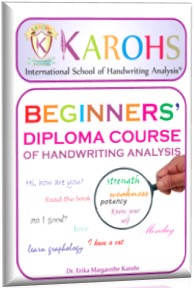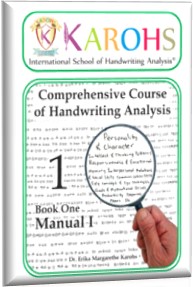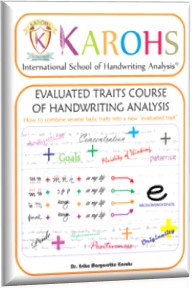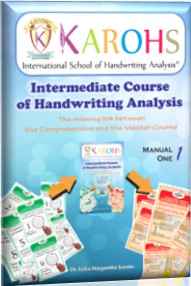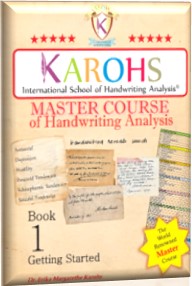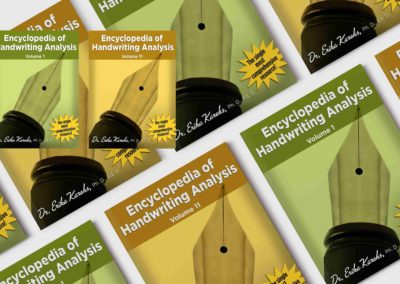Free Article about Handwriting Analysis
From “Sunday Lessons III”
- Sunday Lesson #3: Thinking Patterns
As most of you know, students are sending all kinds of questions to me on a daily basis. Every so often, I’ll include one of general interest with the Sunday lessons.
Student Question:
I would really like to understand the difference between the thinking patterns.
I am a methodical (cumulative) thinker and I’ve got that one down. What is confusing to me are the comprehensive, analytical and investigative thinkers.
In graphology, thinking has to do with HOW the person thinks, now what he thinks about or how much quality there is to his thinking.
“HOW” breaks down into four categories.
(1) Cumulative or methodical thinker – the person who is inclined to consciously process “new” ideas or challenges through a thought process.
(2) Comprehensive thinker – the person who is prone to allow his automatic reactions – based on memories of past experiences – to determine his thoughts in the moments.
(3) Analytical thinker – the person who feels that it is necessary to analyze everything about a given situation (whether he is familiar with it or not) before he is comfortable enough to take action.
(4) Investigative thinker – the person with an inquisitive mind and the desire to explore for himself whatever interests him. He will not be satisfied with second-hand information.
CUMULATIVE THINKING
Handwriting indicator:
Rounded tops on letters m and n indicate cumulative thinking. They are intensified by flat topped “r’s.”
The cumulative thinking pattern
Cumulative thinkers consciously process new information in a step-by-step manner to understand it completely. They are concerned with the whole process and each step involved. When they are thinking things through they need time, which means they have a slower pace of learning – until they grasp all the facts. They are easily under a great deal of pressure to “hurry up” in learning situations. When such pressure is put on them, their minds tend to go “blank.” And they are usually very irritated when they have to work with faster thinkers.
When cumulative thinkers don’t have the time and repetition they need to learn the basics of a study, they may never be able to move ahead in that study.
This has nothing to do with the writer’s intelligence, but only with the rate (or speed) of the thought processes.
This does not mean that cumulative thinkers spend all their time in contemplation. Only when they are faced with NEW situations are they likely to take time to think things through.
However, not every situation needs or requires extended thinking before action. In situations that require immediate action, the cumulative thinker is often too slow. He is too deliberate in his reactions in daily life situations much of the time.
Actually, he is quick to think, but slow to react.
Counseling the cumulative client
(a) It is very important for cumulative thinkers to take the time to learn all new subjects by rote so that they become familiar and thus easy to them. It will take longer at the start, but later they will be able to move more smoothly and effectively.
(b) Second, cumulative thinkers must be willing to ask for repetition so that they can learn right at the start of anything or the beginning of any subject. This means asking the teacher to over “it” again; this means asking the people to whom they are being introduced for the first time to repeat their names. With repetition comes ease and skill.
(c) These people must learn to stop “thinking” and just let themselves react when necessary. They don’t have to take the time to think through things they have already thought through before. They can react quickly, if they just allow themselves to do so. Just as the comprehensive thinker can take the time to think, cumulative thinkers can react quickly if they decide to do so.
How can they do this? They have to prepare themselves beforehand, rehearsing, if necessary, for what will be expected of them in any trying or new situation.
Most importantly, cumulative thinkers must be careful to keep above the feelings of desperation which, under pressure, makes their minds blank. When this does happen, it is because they want so much to take the time to think, that being denied that time completely frustrates them.
Cumulative thinkers and marriage
A comprehensive husband simply cannot understand how slow his cumulative wife is to reach a conclusion sometimes. Because he thinks quickly, he thinks she should move along quickly, too. He may even think her “stupid” when she is struggling through a thought process, when he has – to his own satisfaction – already thought it out.
And she will take his natural pattern for criticism of her ways (which it really is) and will be hurt by it, just as she will be hurt by his quicker reaction time. He will always appear to her to be looking down on her when it comes to “thinking.”
And yet, he is one who is not really thinking, after all. He is automatically responding based on past experiences.
The cumulative partner usually has to bear the burden in a marriage. The burden is that of compromising. She (or he) must speed up his reactions to make the comprehensive partner comfortable. Of course, the comprehensive partner has the responsibility to slow down and take the time to match the rhythm of the cumulative thinker. But the comprehensive partner is less likely to do so.
The cumulative child
Cumulative children often have many problems to be dealt with. Often they will be thought “backward,” or “slow,” or even “stupid” by teachers more comprehensive than they are. They need repetition which the teacher may not have the time for during regular class periods.
Cumulative children should prepare their lessons a day or two ahead of the other children to they will feel more secure in recitation periods in class. The more preparation they have, the more secure they will be.
Application to vocation
Research and educational fields are naturals for cumulative thinkers. Any occupation in which planning and theory are involved, will give them satisfaction, as long as the schedule includes enough time for preparation and thought. In other words, cumulative thinkers function best where they can work at their own rhythm.
The influence of other traits
Conscious directed thinking is possible only when the emotional traits are under control. A highly emotional cumulative thinker will be blocked and appear slow even more often than a thinker with low responsiveness.
German grapho-therapists have observed that cumulative children with high emotionality (responsiveness) are often stutterers or stammerers. The reason is that high emotionality allows sounds to escape the mouth before the word or thought or sentence is fully formed in the mind of the cumulative person.
Where is the cumulative thinker at an advantage?
- Where THINKING counts
- Where theory must be grasped
- Where it is important to take the time to think.
Where is the cumulative thinker at a disadvantage?![]()
- Too slow to react in the moment
- Fails to make practical applications
- Cannot think under pressure.
========================================================================
COMPREHENSIVE THINKING
Handwriting indicator:


Upright, needle-like points on middle zone letters, usually in m’s and n’s, show com-prehensive thinking. These needle like points can also occur on other formations, usually h’s. The sharper the point, the keener is the writer’s comprehension.
The comprehensive thinking pattern
The comprehensive thinker grasps points quickly. He applies them to what he already knows and moves quickly into action. He “thinks on his feet.” Wherever things must happen quickly, he functions to advantage. He always appears to have part of his mind on the next step of the project and is rushing forward to that.
But he is not concerned with the process of thought. End results are what he is after. He is quick to deal with effects, slower to understand or search for the cause.
The comprehensive reacts quickly to what goes on around him. But he reacts based on past experience. He thinks “Oh, yes, this situations is just like that other time” and then he acts as he has done before. But his past experiences may often be insufficient in the new situation. No matter how extensive his past experience may be, it cannot fit the needs of every situation. So the comprehensive thinker often acts less effective than he would if he allowed himself the time to think. He jumps to conclusions, which may not always be correct because he fails to consider all the facts of the situation. His biggest weakness is in not taking the time to think, “really” think.”
The comprehensive writer’s quick comprehension allows him to learn things quickly and to obtain the necessary skills in a very short time, though he seldom masters them. He does not necessarily trouble to remember information because it can always be rapidly relearned.
Because he grasps points without visible efforts, the comprehensive writer gets very irritated by people who take longer to process their thoughts. When they don’t, he becomes impatient or he “tunes them out.”
It is very difficult for the comprehensive thinker to be patient with someone for whom things don’t come together as easily. He does not hear them out. He second guesses them. He gets bored with individuals who talk at a slow pace and continually has to hold himself back from finishing their sentences for them. He tends to hurry others along, thereby causing irritation in slower thinkers. The problem he encounters is not with others, but in his own thinking. When he wants to communicate effectively, he has to talk according to the thinking pattern of the other person involved.
Keep in mind, the comprehensive thinker doesn’t think, he just reacts according to what he already knows. He is actually “slow to think.” Reasons, background, and theory – he is likely to dismiss them in favor of acting “right now.”
He may appear brilliant because of his fast answers but shows to less advantage in the long run.
Counseling the comprehensive client
The comprehensive thinker can always think when he wants to. This is all a matter of taking time. First of all he must discipline himself to take the time to work out the “why” of things. He must look at things and then start to THINK through what he wants to do. He cannot afford to jump to any conclusions about anything.
Secondly, he must take the time to think. Because he does have this tendency to move faster than most people, he is prone to miss many things that have real meanings in many situations.
Third, he must discipline himself to hear the other person out, to let them finish. He must give others the chance to make up their own mind at their own rate of speed. He is often guilty of interrupting others, and that is something he has to stop.
The comprehensive child
The comprehensive child needs constant directed activity. He will almost always be a jump ahead of other children (unless they are comprehensive, too). More than that, his parents must show him how to take the time to think. They must help him to sit down an process a thought.
Application to vocation
The field of transportation and communication are naturals for the comprehensive thinker. Any job in which things happen fast will attract him. He is effective where split second decisions are needed. He would be effective in racing, fast sports.
Where is the comprehensive thinker at an advantage?
- Where quick reactions count
- Where quick practical applications are needed
- Where quick action is most important
Where is the comprehensive thinker at a disadvantage?![]()
- Jumps to conclusions
- Fails to learn theory
- Will not take time to think
To be continued in the following Sunday Lessons with Analytical Thinking and Investigative Thinking.
I hope you enjoy “Sunday Lessons Series III”. If you have any questions or would like to recommend topics, please feel free to email me at info@karohs.com
See detail courses programs (click the image below):
The Encyclopedia of Handwriting Analysis
The first edition of the Encyclopedia was published starting in 1986 to provide handwriting analysts with a less frustrating source of information in all areas of the field. Since 2008, volumes 1 through 10 have been thoroughly revised, re-printed and republished. More volumes will follow as they are completed. Aside from offering a reliable source of information, the Encyclopedia also provides fascinating reading on many subjects in the field of handwriting analysis.
The first, original Encyclopedia volumes in 1986 were still written with typewriter, and the following ones that were produced during the 1990’s had illustrations taped into them since computer and desktop publishing capabilities were not nearly as advanced as they are today. For that reason, Dr. Karohs has been and is still revising all 30 volumes. The complete text is being re-edited, in many case updates, and the books are entirely re-formatted. The illustrations in the updated volumes are cleaned and scanned, rather than taped into the text. At this time, 15 volumes have been updated, with volumes 16 through 20 to be available shortly.
Info :
- Pack A : Volume 1-10 (available); Total 1.051 pages
- Pack B : Volume 11-20 (available)
- Pack C : Volume 21-30 (under revision)
Price: $150 per pack (ten volumes)
HOME
COURSE
BOOKS
Copyright © 2018 the KAROHS International School of Handwriting Analysis®. All rights reserved.
No image or portion of this website may be copied or reproduced without written permission.


